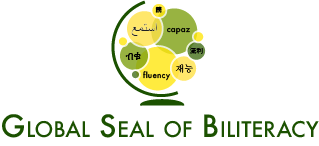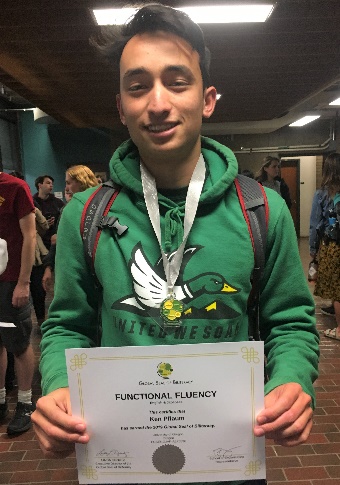By Global Seal of Biliteracy Executive Director Linda Egnatz
In the past month, three significant events signal an opportunity to shift the Seal of Biliteracy paradigm. First, in May, while speaking at the Office of English Language Acquisition (OELA) Multiliteracy Symposium, I had the honor to announce that Southern New Hampshire University (SNHU) now offers a college credit program to any Global Seal of Biliteracy recipient. This means that someone with a Global Seal of Biliteracy in Chinese, Somali or Chin (or any other language we credential) can receive transferable World Language college credit!
Second, the Lead with Languages campaign announced the results of a groundbreaking industry report, based on a survey conducted by Ipsos Public Affairs of 1200 upper-level managers and human resources professionals. The report, “Making Languages Our Business: Addressing Foreign Language Demand Among U.S. Employers,” found that 9 out of 10 US employers rely on U.S. based employees with language skills other than English and that a majority of employers report that their need for foreign languages has increased over the past five years and project that it will continue to grow.
The third event was an inaugural event held by the University of Oregon to issue Global Seal of Biliteracy credentials in six different languages to 210 university students who tested at either the Working Fluency or Functional Fluency level. Students who have demonstrated language skills in French, German, Italian, Japanese, Portuguese and Spanish now have documented their skills with their unique serial-numbered Global Seal of Biliteracy certificate. This empowers and equips recipients with a tangible credential to support a job or study-abroad application and can be added to LinkedIn or other job search platform profiles.
The danger in treating a Seal of Biliteracy as just an award is that it suggests to the recipient that they have finished the race or competition. It was intentional that the Global Seal’s first award level be named “Functional Fluency” at the Intermediate-Mid level of proficiency on the ACTFL Scale. It is at this level, that the awardee has just begun to be an independent player on the field of real meaningful second-language interactions. Most state Seals of Biliteracy also recognize one of the three Intermediate level of language use, but it should be noted that there are many more levels of language proficiency to go! If we truly want learners to engage in on-going acquisition to meet their personal goals and/or the needs of the workplace, we MUST view the Seal not as a final award, but rather the acknowledgment of language skills – a useful and meaningful CREDENTIAL, but one that could and should be LEVELED-UP.
Rather than give an award that recognizes language skills in two or more languages; consider the Seal an opportunity to provide bilinguals with useful language credentials that can be used to accomplish personal goals. Global Seal of Biliteracy recipients have used their credential to get scholarships and have included their Global Seal of Biliteracy awards on LinkedIn and on college applications. Educators need to be intentional and must articulate to both learners and their parents the true value of the award to maximize its benefits. Higher level course placement and scholarships save students thousands of dollars in tuition. Share with recipients the importance of differentiating oneself on a job application as bilingual. According to the IPSOS survey, “A third (34%) of U.S. employers reliant on foreign languages say their foreign language needs are not currently being met by their employees.”
It is my dream that thousands of state and Global Seal of Biliteracy recipients will turn their trophy into a tool by using it as a credential to achieve greater academic and employment opportunity. I can’t wait until the Global Seal is regularly listed under “Licenses & Certifications” on LinkedIn. It would be even more exciting if language educators would take the risk to be tested to determine their own level of language proficiency; then model for their learners the value of “leveling-up” with their own credential trail. Most of all, I hope to see bilingualism recognized in the United States as one of the most sought after CREDENTIALS to have. The Seal of Biliteracy is not a “one and done” award to frame or file away, it is an empowering tool that recipients should use to impact their futures in ways beyond their imaginations.



